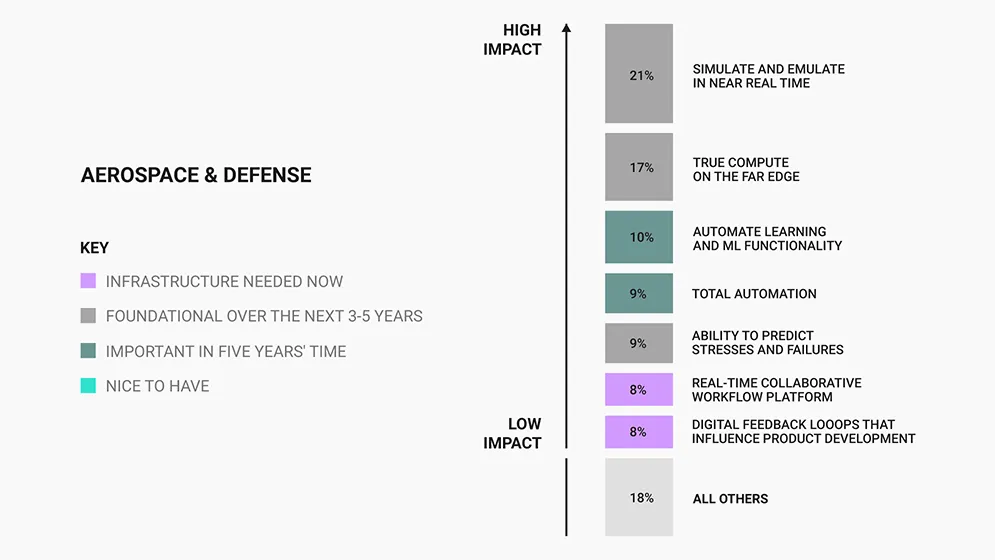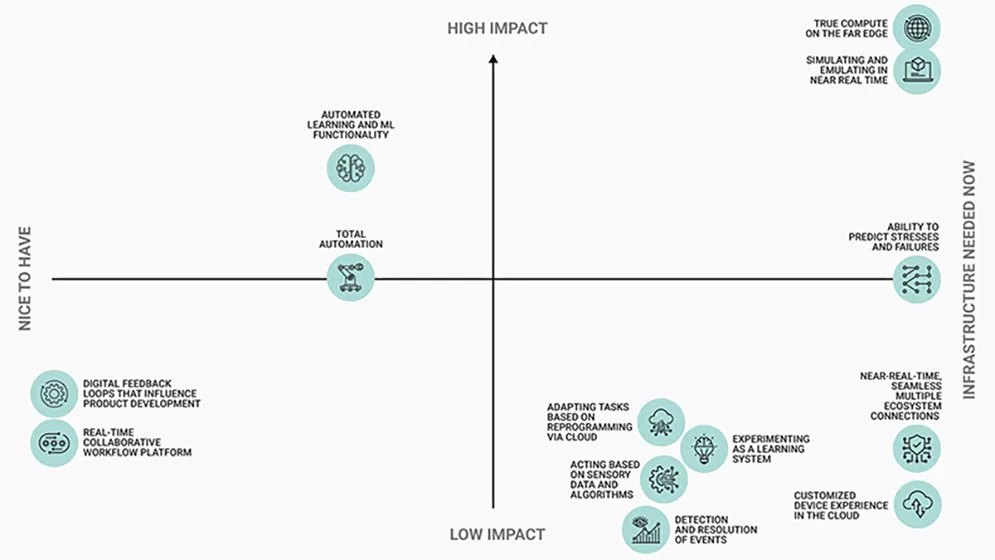What Are Intelligent Systems?
Intelligent systems, also referred to as artificial intelligence (AI) systems, aim to replicate human-like intelligence and decision-making processes. These systems are designed to collect and analyze data, learn from it, and make informed decisions or predictions. At the core of intelligent systems lies machine learning, a subset of AI that enables systems to improve their performance over time without being explicitly programmed.
Intelligent systems rely heavily on data, collecting vast amounts of information for decision-making and learning. They process and analyze this data by using algorithms that can make predictions and decisions. Intelligent systems can also learn from exposure to data. And because they rely on automation, they reduce the need for human intervention in some repetitive tasks and decision-making processes.
» Learn More About Intelligent Systems
Intelligent systems vastly improve the capabilities of the aerospace and defense industry.
What are the Top Characteristics of Successful A&D Intelligent Systems?
The success of intelligent systems relies on a combination of characteristics that are essential to their development, deployment, and continued operation — in fact, to their effectiveness and impact.
Across industries, these characteristics include quality and quantity of data, robust algorithms, scalability, high performance, user-centered design, a commitment to ethical considerations, continuous learning and adaptation, and a tangible return on investment.
Characteristics Needed in Intelligent Systems in A&D
In the aerospace and defense sector, intelligent systems play a pivotal role in enhancing mission success, ensuring safety, and optimizing operational efficiency. Certain critical characteristics must be tailored to the unique demands of this sector.

Specific characteristics increase the safety and security of intelligent systems in A&D.
Attributes that are essential for intelligent systems in aerospace and defense include:
- Simulation and emulation in near real time: The inherent complexity and volume of mission-critical capabilities mean that A&D systems must compute, sense, and connect in near real time. Intelligent systems must process vast amounts of data swiftly and provide instantaneous responses, so low-latency capabilities are vital.
- True compute on the far edge: To support their low-latency capabilities, aerospace and defense applications must be able to fully function in near-latency-free mode even on the farthest edge of the cloud.
- Security and cyber resilience: In an era of increasing cyberthreats, intelligent systems must be designed with robust cybersecurity measures to protect against cyberattacks, data breaches, and unauthorized access. They should adhere to the strictest security standards and continuously monitor for vulnerabilities.
- Real-time collaborative workflow: The A&D sector involves a complex ecosystem of platforms, technologies, and stakeholders. Intelligent systems must seamlessly integrate with existing infrastructure and collaborate with other systems, ensuring that information and resources can be shared efficiently in joint operations.
- Automated learning, machine learning, and total automation: The ability to infuse automation (AI) and machine learning (ML) throughout the lifecycle of a device or system, from the moment development starts, is necessary because intelligent systems often assist human operators in decision-making processes. They should be equipped with advanced decision support algorithms and the ability to operate autonomously when required, such as in unmanned aerial vehicles (UAVs) or autonomous defense systems.
- Situational awareness and the ability to predict stresses and failures: Intelligent systems must fuse data from various sensors, including radar, GPS, and imaging, to offer a complete picture of the environment. They should also have predictive capabilities to anticipate threats and opportunities.
- Digital feedback loops: The ability to synthesize workflows with one process for all parties involved, using digital feedback loops to influence new product and service development, brings people, data, and new collaborative work processes to the forefront in A&D intelligent systems. Examples such as Air Force Platform One are based on the concept of the constant development, deployment, and operation of complex systems responding in near–real time to digital feedback loops.
- Scalability: As the demands of the aerospace and defense sector evolve, intelligent systems must scale to accommodate increased data volumes, sensor inputs, and processing requirements, especially in dynamic environments.
- Regulatory compliance: A&D is a highly regulated industry. Strict regulatory and compliance standards ensure both safety and security. Compliance certifies systems for use in mission-critical applications.
- Mission flexibility: Intelligent systems should be versatile and programmable to handle diverse tasks, whether surveillance, reconnaissance, communication, or tactical decision support.
- Human–machine collaboration: In many A&D scenarios, human operators collaborate closely with intelligent systems. Effective human–machine interfaces and transparent communication between humans and systems are essential for mission success and operator trust.
- Reliability and redundancy: Above all else, intelligent systems in this sector must be exceptionally reliable. System failures in areas such as aircraft control or missile defense can have catastrophic consequences. Redundancy and fail-safe mechanisms are crucial to ensure continuous operation even in the face of hardware or software failures.
Building out Critical Characteristics in the Aerospace and Defense Industry
Forbes and Wind River® research into A&D executives’ views of critical characteristics for intelligent systems success in their sector revealed the most impactful areas of focus for development, starting now and carrying into the next five years:

Figure 1. Industry executives’ ranking of the key characteristics that drive success in intelligent systems in A&D
Compared to other major industries, A&D requires the most advanced design for intelligent systems success. By addressing the factors shown in Figure 1 during development and throughout the system’s lifecycle, organizations can maximize the value and impact of intelligent systems in various applications and domains.
What’s more, knowing when to invest in each characteristic means creating a blueprint for building critical infrastructure, delivering core foundational needs, and much more. For A&D, our research shows the temporal criticality of each characteristic:

Figure 2. A&D leaders ranked the need for each characteristic according to a five-year timeline
Of the A&D leaders surveyed, 59% believe that their ROI will outweigh the level of effort and cost needed to develop these characteristics.
How Can Wind River Help?
Wind River Edge
VxWorks
VxWorks® is a real-time operating system (RTOS) that is widely used in intelligent systems in A&D and other industries, including automotive, industrial, medical, and more. It provides a robust and reliable foundation for developing and running embedded and real-time applications. VxWorks is often used in autonomous vehicles, robotics, and critical infrastructure systems for which real-time performance and safety are paramount.
» Learn More About VxWorks
Wind River products have a long history of successful use in aerospace and defense.
Wind River Helix Virtualization Platform
Wind River® Helix™ Virtualization Platform enables the consolidation of multiple operating systems and applications on a single hardware platform. It’s commonly used in intelligent systems that run multiple operating systems or applications in isolated environments where both real-time and general-purpose operating systems may coexist. Simplify, secure, and future-proof your aerospace and defense systems with Helix Platform.
» Learn More About Helix PlatformWind River Linux
Wind River offers a commercial-grade Linux distribution tailored for embedded and intelligent systems. Wind River Linux includes tools and features for building secure, high-performance, and customizable Linux-based platforms. It’s often used in networking equipment, medical devices, IoT devices, and other embedded intelligent systems.
Wind River Linux also delivers military-grade Linux with a combination of system-level security reinforcements, such as access control mechanisms and intrusion detection and prevention tools, with long-term security update strategies for deployed devices. With validated, maintained, and supported source code, as well as a comprehensive suite of services including CVE monitoring, Wind River Linux is certified for ISO 9001 and for conformance to the FACE™ Technical Standard.
» Learn More About Wind River LinuxWind River Studio
Wind River Studio is a cloud-native platform for the development, deployment, and operation of intelligent systems and IoT devices. It provides tools and services for managing the entire lifecycle of intelligent systems, including development, deployment, and monitoring.
For aerospace and defense development teams modernizing or transforming the development, deployment, and operation of their intelligent systems, Studio has been architected to easily scale to simultaneously run different projects with multiple operating systems and hardware architectures, all from a single pane of glass.
» Learn More About Studio » Learn How Wind River Can Help with All of Your A&D Needs
